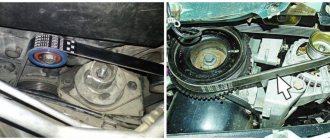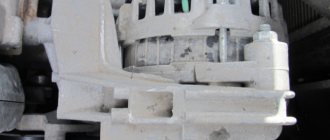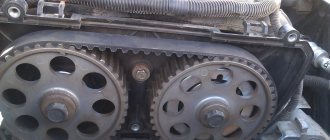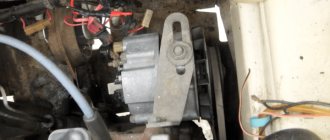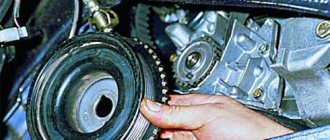Timing belt tension: algorithm of actions
The timing belt is an element in the engine design that connects the camshaft and crankshaft, organizing the timely opening and similar closing of the valves. The belt drive must always be well tensioned; as a result, engineers have introduced special tensioners into the design of the gas distribution mechanism. Few people know, but not only the service life of the belt itself, but also the unit as a whole depends on proper tension settings. We will talk in more detail about how to tighten the timing belt, and when such an operation may be required, in the article given today.
In what cases is it worth replacing the belt? Signs that it is time to change the timing drive.
Replacing and tensioning the belt is carried out in two cases, namely:
- when a routine check of the entire gas distribution mechanism is carried out;
- if repairs were made to elements of the timing system.
To find out if the belt is tensioned correctly, you need to do the following. Take a regular canter and a ruler. Then everything is simple. Hook the canter hook onto the timing belt and pull. The scale dial should show a value of 10 kilograms. At this moment, measure the distance by which the drive has deviated. If the value is less than 5 and a half millimeters, then the tension is normal. When the value is greater than the specified figure, the timing belt needs to be tensioned.
A few words about the importance of correct tension
Many motorists know that improper functioning of the timing belt can cause very serious engine damage. This is due to the principles of operation of the mechanism, which boil down to the timely and high-quality opening/closing of the engine valves. This approach not only allows you to adjust the valve timing of the internal combustion engine, but also differentiates between sensitive valves and constantly knocking pistons.
If the timing belt begins to work incorrectly, the gas distribution order is disrupted, as a result of which engine elements begin to wear out at an accelerated rate. Similar disturbances in the functioning of the engine can also occur due to improper belt tension.
Note! A break in the belt drive while driving not only negatively affects the condition of the engine, but can actually severely bend the valves. Repairing a car with such a breakdown often costs motorists five-digit sums of money.
In addition, drive tension that does not meet the standards accelerates wear of the main timing elements, the list of which includes:
- directly the belt drive itself;
- rollers;
- torque clutches;
- guides;
- tensioner
Repair of each of the marked timing parts takes much longer than normal belt tensioning. Well, there is nothing to say about the cost, if you can tighten the drive yourself and completely free of charge, then you will have to pay for replacing the components of the mechanism.
What is the danger of deformation and rupture of the timing drive?
The belt ensures proper operation of the valves. The belt is tensioned on the camshaft and crankshaft wheel. Therefore, it regulates the process of closing and opening the valves at certain times. If you skip replacing the belt, serious damage to your car's engine may occur. Most often, a rupture of the belt drive while driving leads to cranking and bending of the valves. Such a breakdown will cost much more to repair than replacing a belt.
In addition, due to stretching or weakening of this drive, other serious problems may occur. In this case, an incorrect gas distribution process is observed. At the same time, other elements of the engine structure also begin to wear out faster.
Timely replacement of the timing belt will prolong the operation of the engine and the car as a whole.
When does the belt need to be tightened?
Having considered the previous paragraph of the article, it was probably not difficult to understand that monitoring the correct functioning of the timing belt is quite important. In particular, it is worth keeping the belt drive tension at the proper level. By the way, stretching is carried out only in two main cases:
- During a routine check of the gas distribution mechanism and the tension does not comply with the norm. The normal tension of the timing belt is checked in a very simple way, for which you will need ordinary spring scales and a ruler or caliper. To check, the hook of the scale clings to the belt and pulls until the display shows a load of 10 kilograms. Without loosening your grip, all that remains is to measure the deviation of the drive from the normal position. If the belt has been pulled back by more than 5.5 millimeters, but its tension is inevitable. Otherwise, you can leave everything as is until the next timing check, which is recommended every 10-15,000 kilometers;
- When repairing the timing belt, when the belt was removed or its tension was weakened.
VAZ "Ten"
A popular car equipped with an engine with a timing belt drive. The manufacturer recommends replacing the rubber band of the GRS mechanism after 40-45 thousand kilometers, but diagnostics cannot be neglected before this period. The principle of “installing a new belt and forgetting about it” must be eradicated, understanding that being guided by this rule will not lead to anything good.
Attention. It is very important to regularly diagnose the technical condition of the belt and its tension.
In order to check the tension today, special electronic devices are used, although you can do without them. Only on the timing rubber product itself there should not be a drop of oil, dirt or signs of tear. Everything must be almost perfectly clean, without delamination, for the diagnosis to be most effective. Otherwise, it is better not to bother with diagnostics, but to immediately replace the belt with a new one, eliminating the reason why it was worn out or lubricant got on it.
Checking tension with a steelyard
Another important condition: the check must be carried out on a cold internal combustion engine.
The checking and adjustment process itself is as follows:
Now directly about the diagnostic process:
Attention. If the tension is accurate, the deflection should be 5.4 mm. Otherwise, adjustments will have to be made. If the value is less, then the tension is too strong; if it is more, the belt is too loose.
The adjustment is carried out as follows:
Note. The nut should be fixed so that the roller does not move and cannot be released.
It is also important to remember that excessive tension on the rubber timing ring reduces its service life and can easily lead to failure of the tensioner roller and even the pump. You should not listen to those false masters who claim that strong tension will supposedly eliminate all problems with the belt.
Weak tension always means the belt jumps over the teeth of the camshaft sprocket, which inevitably leads to disruption of the phases of the hydraulic valve mechanism. On the contrary, a strong tension is wear by the bearing of the same roller or water pump, as well as direct wear of the belt.
The tension can also be checked using a special device, such as “Contiteg”. The principle of its operation is quite simple, you just need to measure the amplitude of the belt vibrations.
The device always comes with a detailed description of its operation in a case. It consists of a device with readings, as well as a sensor, which must be brought to the belt (at a distance of 1 cm).
Attention. It is extremely important that the sensor “overlaps” the belt with only half its length.
Stretching procedure
Let's say the timing belt on your car is literally slipping, or its tension is slightly off from the norm. What to do? Naturally, tighten the drive. Fortunately for many motorists, the tightening procedure is not so complicated and is completed within 5-10 minutes. To carry it out you will need the following tools:
- a timing belt adjustment key, the design of which is quite simple, so it is not necessary to buy it, but can be made with your own hands;
- basic set of wrenches.
The actual tensioning procedure goes like this:
- First of all, we park the car in a place convenient for repair and disconnect the battery (just disconnect the negative terminal);
- Then we tear off the hood and remove the protection from the timing belt, of course, if there is one;
- After this, loosen the nut securing the tension roller;
- Next, using a special key to adjust the belt tension, we tighten it. To do this, we insert the “horns” of the key into special holes on the adjusting nut, which is located in the area of the previously loosened fastening of the tension roller. Adjusting the belt tension is carried out by twisting a special key counterclockwise;
- Having tensioned the drive as required, fix the tension roller in a stationary position and tighten its fastening;
- Recheck the belt tension. If something is wrong, we fix it;
- Otherwise, we bring the car back to its original condition, after which the repair can be completed.
Note! During repair work, you need to act carefully, without damaging adjacent timing elements. Often, the carelessness of inexperienced car repair workers complicates their lives by requiring additional repairs.
Perhaps this is where the most important information on timing belt tensioning has come to an end. We hope that the material presented today was useful to you and provided answers to your questions. Good luck in operating and maintaining your car!
Timing belt - checking the tension and replacing the timing belt
The timing belt is replaced every 60,000 km. mileage, in addition, the belt must be checked periodically (every 15,000 km) and if cracks, delaminations, deformations, defects, or traces of oil are found on it, then the belt is replaced. If traces of oil are found on the belt, the cause of the oiling must be immediately eliminated. (most likely this is due to the crankshaft and camshaft seals). A timing belt break, wear or shearing of its teeth can lead to engine damage and costly repairs.
Gas distribution mechanism: 1 – crankshaft toothed pulley; 2 – timing belt; 3 – tensioner roller; 4 – toothed pulley of the camshaft driving the exhaust valves; 5 – toothed pulley of the camshaft driving the intake valves; 6 – support roller; 7 – coolant pump toothed pulley
Checking the timing belt on VAZ 2108, 2109, 21099 engines
The timing belt is checked once every 15 thousand kilometers. The following is checked:
— degree of wear of the timing belt;
— degree of tension of the timing belt.
Preparatory work
— Remove the cover of the gas distribution mechanism drive.
— We stock up on a special key for rotating the belt tension roller.
Checking the timing belt
- Check the belt wear. Visually inspect the belt along its entire length. To do this, turn the crankshaft clockwise (using a screwdriver at the flywheel splines in the clutch housing hatch). If cracks are found on the belt, its delamination, teeth are torn off, or oiling occurs, replace the belt with a new one.
VAZ "Ten"
A popular car equipped with an engine with a timing belt drive. The manufacturer recommends replacing the rubber band of the GRS mechanism after 40-45 thousand kilometers, but diagnostics cannot be neglected before this period. The principle of “installing a new belt and forgetting about it” must be eradicated, understanding that being guided by this rule will not lead to anything good.
Attention. It is very important to regularly diagnose the technical condition of the belt and its tension.
In order to check the tension today, special electronic devices are used, although you can do without them. Only on the timing rubber product itself there should not be a drop of oil, dirt or signs of tear. Everything must be almost perfectly clean, without delamination, for the diagnosis to be most effective. Otherwise, it is better not to bother with diagnostics, but to immediately replace the belt with a new one, eliminating the reason why it was worn out or lubricant got on it.
Checking tension with a steelyard
Another important condition: the check must be carried out on a cold internal combustion engine.
The checking and adjustment process itself is as follows:
Now directly about the diagnostic process:
Attention. If the tension is accurate, the deflection should be 5.4 mm. Otherwise, adjustments will have to be made. If the value is less, then the tension is too strong; if it is more, the belt is too loose.
The adjustment is carried out as follows:
Note. The nut should be fixed so that the roller does not move and cannot be released.
It is also important to remember that excessive tension on the rubber timing ring reduces its service life and can easily lead to failure of the tensioner roller and even the pump. You should not listen to those false masters who claim that strong tension will supposedly eliminate all problems with the belt.
Weak tension always means the belt jumps over the teeth of the camshaft sprocket, which inevitably leads to disruption of the phases of the hydraulic valve mechanism. On the contrary, a strong tension is wear by the bearing of the same roller or water pump, as well as direct wear of the belt.
The tension can also be checked using a special device, such as “Contiteg”. The principle of its operation is quite simple, you just need to measure the amplitude of the belt vibrations.
The device always comes with a detailed description of its operation in a case. It consists of a device with readings, as well as a sensor, which must be brought to the belt (at a distance of 1 cm).
Attention. It is extremely important that the sensor “overlaps” the belt with only half its length.
Checking the timing belt on VAZ 2108, 2109, 21099 engines
The timing belt is checked once every 15 thousand kilometers. The following is checked:
— degree of wear of the timing belt;
— degree of tension of the timing belt.
Preparatory work
— Remove the cover of the gas distribution mechanism drive.
— We stock up on a special key for rotating the belt tension roller.
Checking the timing belt
- Check the belt wear. Visually inspect the belt along its entire length. To do this, turn the crankshaft clockwise (using a screwdriver at the flywheel splines in the clutch housing hatch). If cracks are found on the belt, its delamination, teeth are torn off, or oiling occurs, replace the belt with a new one.
- Check the belt tension. The belt should not be overtightened or loosened. Using two fingers, turn the belt 90º (see photo above). The turning force should be within 15-20N.m (1.5-2.0 kgf.m), which is not too large.
If the applied force is not enough to turn the belt, it means it is too tight and needs to be loosened; if the belt can be turned to a larger angle, it means it is not tensioned enough and needs to be tightened.
To do this, use a 17mm wrench to loosen the tension roller nut.
Using a special wrench, we rotate the tension roller, loosening or, conversely, tightening the belt.
Check the belt tension again and tighten the roller fastening nut. Tightening torque 33.2 - 41.2 N.M (3.4-4.2 kgf.m). You should not apply more force, as you can bend the roller pin and then the belt will be driven off the pulley.
- We check the alignment of the engine timing marks. See "Timing marks for engines 21083, 21081, 2108".
VAZ "Ten"
A popular car equipped with an engine with a timing belt drive. The manufacturer recommends replacing the rubber band of the GRS mechanism after 40-45 thousand kilometers, but diagnostics cannot be neglected before this period. The principle of “installing a new belt and forgetting about it” must be eradicated, understanding that being guided by this rule will not lead to anything good.
Attention. It is very important to regularly diagnose the technical condition of the belt and its tension.
In order to check the tension today, special electronic devices are used, although you can do without them. Only on the timing rubber product itself there should not be a drop of oil, dirt or signs of tear. Everything must be almost perfectly clean, without delamination, for the diagnosis to be most effective. Otherwise, it is better not to bother with diagnostics, but to immediately replace the belt with a new one, eliminating the reason why it was worn out or lubricant got on it.
Checking tension with a steelyard
Another important condition: the check must be carried out on a cold internal combustion engine.
The checking and adjustment process itself is as follows:
Now directly about the diagnostic process:
Attention. If the tension is accurate, the deflection should be 5.4 mm. Otherwise, adjustments will have to be made. If the value is less, then the tension is too strong; if it is more, the belt is too loose.
The adjustment is carried out as follows:
Note. The nut should be fixed so that the roller does not move and cannot be released.
It is also important to remember that excessive tension on the rubber timing ring reduces its service life and can easily lead to failure of the tensioner roller and even the pump. You should not listen to those false masters who claim that strong tension will supposedly eliminate all problems with the belt.
Weak tension always means the belt jumps over the teeth of the camshaft sprocket, which inevitably leads to disruption of the phases of the hydraulic valve mechanism. On the contrary, a strong tension is wear by the bearing of the same roller or water pump, as well as direct wear of the belt.
The tension can also be checked using a special device, such as “Contiteg”. The principle of its operation is quite simple, you just need to measure the amplitude of the belt vibrations.
The device always comes with a detailed description of its operation in a case. It consists of a device with readings, as well as a sensor, which must be brought to the belt (at a distance of 1 cm).
Attention. It is extremely important that the sensor “overlaps” the belt with only half its length.
How to check and adjust the timing belt on a VAZ 2113, 2114, 2115
Author: remontnik · Published 12/22/2016 · Updated 12/07/2018
It is recommended to check the timing belt every 15,000 km during the next maintenance.
To perform this work, you will need a timing belt tensioner.
Using a 10mm wrench, unscrew the 3 bolts securing the front timing belt cover.
Lift it vertically up and remove it from the engine.- We turn the crankshaft and visually check the condition of the belt. The crankshaft can be turned with a 17 or 19 wrench using the pulley bolt. Visually the belt should be clean. If the belt shows signs of wear, cracks, or delamination, it definitely needs to be replaced.
Try turning the belt 90 degrees with two fingers. You need to pull in the area between the crankshaft and camshaft pulleys, applying a force of 15–20 N m (1.5–2.0 kgf m). If you can’t turn it, it means the belt is too tight. If the belt can be turned to a greater angle, it is loosely tensioned. Attention! The belt must be adjusted on a cold engine. An overtightened belt will shorten the life of the belt itself, the tension roller bearings and the coolant pump. Weak belt tension can cause the belt to jump over the camshaft teeth.- In order to check the relative position of the camshaft and crankshaft, you need to install the piston of the 1st cylinder at TDC of the compression stroke. For this:
a) It is necessary to remove the plug in the upper part of the clutch housing.
b)
In this window, use a screwdriver to turn the crankshaft by the teeth of the flywheel ring
until the mark on the camshaft pulley and the protrusion of the rear timing belt cover align.
In this case, the mark on the flywheel should align with the center of the scale.
If the relative position of the crankshaft and camshaft is disturbed, then turn the crankshaft until the mark aligns with the center of the scale. Loosen the belt tension and remove it from the camshaft pulley. Turn the camshaft until the mark on its pulley aligns with the protrusion on the rear cover. Without changing the relative position of the shafts, put the belt on the camshaft pulley and adjust the belt tension.
7. Use a 17 mm wrench to loosen the tension roller mounting nut.
8. By turning the roller with a special wrench, we adjust the belt tension and, holding the roller in this position, tighten the nut that secures it.
9. Check the belt tension (see above) and, if necessary, repeat the adjustment.
10. Finally tighten the roller fastening nut to a torque of 33.2–41.2
11. Reinstall the front belt cover and tighten its fastening bolts.
Timing belt tension VAZ 2110, 2111 (8 cl.)
Checking the timing belt tension means that the front branch of the belt is twisted 90° with the thumb and forefinger of the hand with a slight force of 15–20 N (1.5–2.0 kgf). Here questions arise: how to calculate the force? Everyone’s finger strength is different, how do you determine the required strength? You need to tension the timing belt so that in the longest section you try to turn it 90 degrees with 2 fingers, and if this is almost possible, then the belt is tensioned normally.
Try tightening the timing belt and keep in mind that
- If the belt is too tight, you won't be able to turn it 90 degrees with any fingers.
- if you don’t tighten it enough, the belt will dangle and hit the plastic casing (this shouldn’t happen). We tighten it until the sound disappears at idle and when accelerating.
As a result, if the timing belt tension is correct, then when the casing is removed, its long part will fluctuate within 1 cm. from the axis.



